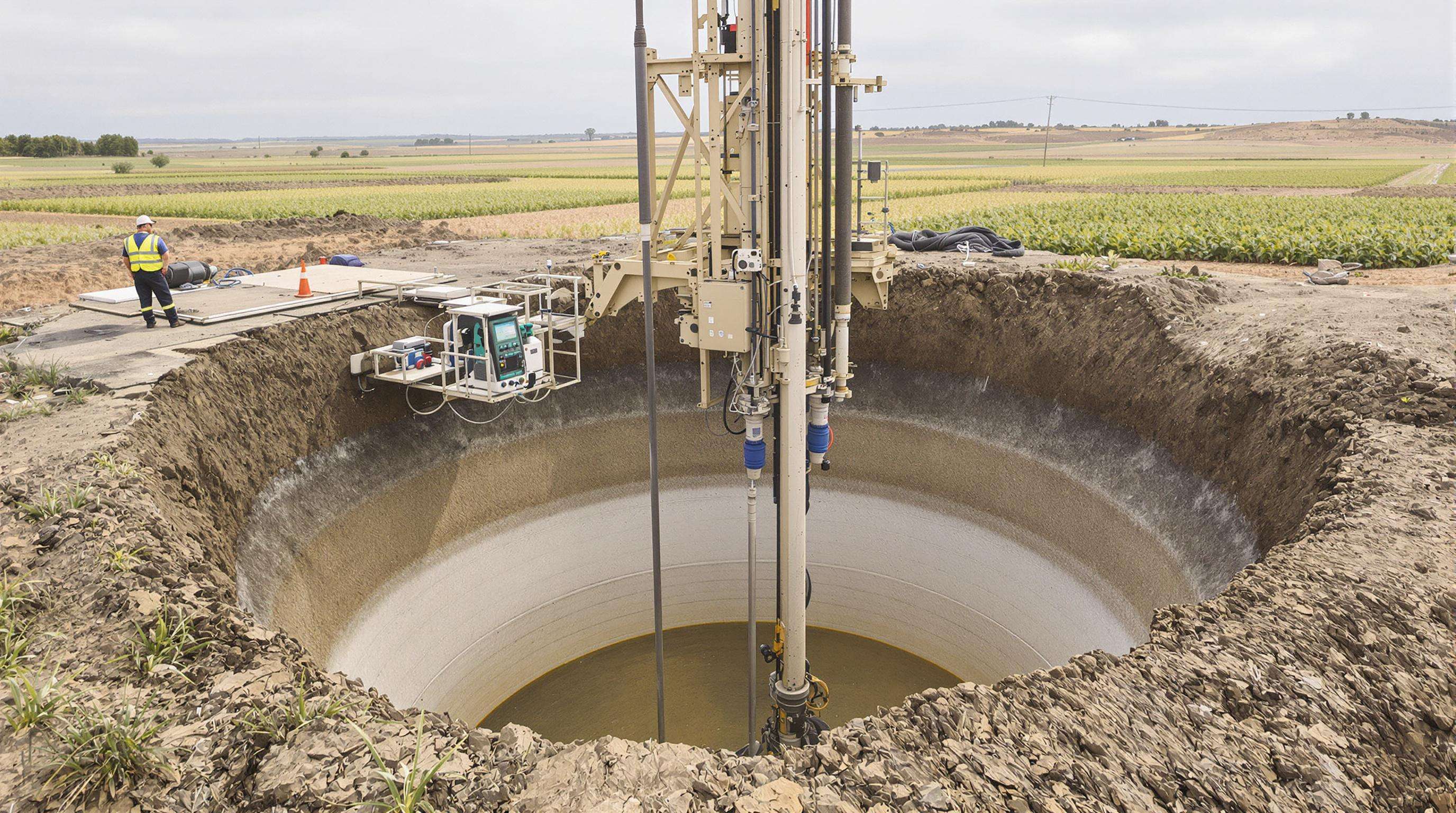How High-Quality Borehole Drilling Machines Support Sustainable Groundwater Management

Linking machine quality to long-term groundwater sustainability
Investing in precision-engineered borehole drilling machines directly supports sustainable aquifer management. High-quality equipment creates structurally sound boreholes that maintain hydrologic balance over decades, reducing risks like land subsidence. In contrast, substandard machines often lead to repeated interventions—each causing 8–15% more sediment release into aquifers, according to 2024 hydrogeological field surveys.
The consequences of inefficient drilling on aquifer depletion and resource waste
Poorly performing machines accelerate groundwater degradation through three key failures: imprecise depth control that breaches aquitards, vibration-induced fractures allowing surface contaminants, and misaligned boreholes requiring multiple drilling attempts. These inefficiencies significantly increase water waste and extend aquifer recovery times, as shown in data from the 2023 Global Groundwater Sustainability Index:
| Drilling Efficiency | Water Waste Per Project | Aquifer Recharge Time |
|---|---|---|
| High-Quality Machine | 120–200 gallons | 6–9 months |
| Substandard Machine | 500–800 gallons | 2–4 years |
This highlights how inefficient drilling not only wastes resources but also delays natural aquifer regeneration.
Case study: Substandard machines leading to reduced water yield
A municipal water project along the coast of Ghana started out using cheaper, non-certified drilling equipment to save money at first. But within just eighteen months, nearly half of all the boreholes experienced serious problems with their output dropping between sixty to seventy percent because of faulty casings and misaligned drill bits. Fixing these issues ended up costing around seven hundred forty thousand dollars according to Ponemon's research from last year, which is actually three times what good quality certified machinery would have cost originally. When they finally switched over to ISO certified drilling rigs though, things turned around pretty quickly. The water extraction became stable again and ongoing maintenance expenses went down by almost four fifths compared to before.
Technological Innovations Enhancing Sustainability in Borehole Drilling Machines

Modern borehole drilling machines integrate advanced technologies to improve efficiency while minimizing environmental impact. These innovations enable precise, eco-conscious groundwater development.
Smart Drilling: Integration of Automation, IoT, and GPS for Precision and Efficiency
Automation combined with IoT sensors and GPS tracking allows drilling accuracy within ±1.5 cm, reducing off-target drilling by up to 92% (GeoResource Journal 2024). This precision limits soil disruption and lowers contamination risks. Field studies show IoT-equipped rigs complete projects 30% faster and use 18% less fuel than conventional models.
| Feature | Traditional Drilling | Smart Drilling |
|---|---|---|
| Depth Accuracy | ±15 cm | ±1.5 cm |
| Fuel Consumption | 45 L/hour | 37 L/hour |
| Drilling Speed | 8 m/day | 12 m/day |
Real-Time Monitoring Systems for Sustainable Drilling Operations
The onboard analytics system processes geological information at a rate of about 200 samples every second, constantly tweaking drill pressure and rotational speed based on what's happening underground. This helps avoid drilling too much in delicate aquifer areas, something that matters a lot for most sustainable groundwater projects these days. According to the Water Resource Management Report from last year, this approach is crucial for around three out of four such initiatives. When operators get warnings about getting close to environmental limits, they can make changes on the spot. These quick responses cut down on wasted resources significantly, somewhere between twenty and thirty five percent according to field tests.
The Shift from Mechanical to Digitally Integrated Borehole Drilling Machines
Digital hydraulic systems replace manual controls, cutting maintenance downtime by 40% and improving energy efficiency. A 2024 industry analysis found fully electric rigs emit 62% less CO₂ than diesel-powered equivalents. These machines automatically log performance data for lifecycle optimization, supporting continuous improvements across operations.
Environmental and Energy Efficiency Benefits of Modern Borehole Drilling Machines
Reducing Carbon Footprint With Eco-Friendly Drilling Techniques
Modern drilling machines reduce CO₂ emissions by 40–60% through optimized energy use and waste reduction. Electric rigs eliminate on-site diesel exhaust, while advanced cuttings management prevents soil contamination. According to a 2023 Hydrogeology Journal study, directional drilling reduces surface disturbance by 75%, preserving ecosystems during groundwater projects.
Hybrid and Electric Drilling Machines: Lower Emissions and Higher Efficiency
Battery-electric models achieve 20–30% lower operational costs (2025 Sustainable Mining Report) while matching the torque of diesel rigs. Key benefits include:
- 90% reduction in particulate emissions
- 50% fewer moving parts, reducing maintenance needs
- Regenerative braking systems that recover 15–20% of energy
These machines allow silent, zero-emission operation, making them ideal for urban or environmentally sensitive areas.
Energy-Efficient Equipment in Sustainable Groundwater Management Frameworks
Leading water authorities now require energy efficiency ratings for drilling equipment in national policies. Variable-frequency drives adjust power based on real-time geology, cutting energy waste by 25–40% in mixed strata. Automated drilling fluid recycling reduces water use by 60%, and real-time telemetry prevents overshooting target depths—helping avoid aquifer over-extraction.
Selecting the Right Borehole Drilling Machine for Geological and Operational Needs
Matching Machine Capabilities to Geological Conditions and Drilling Depth
Choosing a machine aligned with subsurface conditions ensures efficiency and protects aquifer integrity. For example:
- Granite bedrock requires rigs with ¥15 kW torque and diamond-core bits to sustain drilling speeds above 2 meters/hour.
- Alluvial sediments demand dual-wall reverse circulation systems to prevent collapse.
A 2023 hydrogeological study found mismatched equipment increases aquifer disturbance by 37% and shortens borehole lifespan by 4–7 years. For depths beyond 150 meters, automated feed control is essential—manual rigs exhibit 23% higher deviation rates at these depths.
Adapting Drilling Technology to Regional Hydrogeology for Optimal Performance
In coastal regions with saline aquifers, corrosion-resistant machines with stainless-steel casings and polymer-coated drill pipes reduce maintenance by 60% compared to carbon steel. In fractured limestone, directional drilling attachments increase water yield by 41% by following natural fissures.
In arid zones with deep water tables (300+ meters), hybrid diesel-electric rigs reduce fuel consumption by 18% during extended operations. Proper geological assessment before deployment lowers dry borehole rates from 1:5 to 1:11, based on 2022 field data.
Lifecycle Value: Durability, Maintenance, and ROI of High-Performance Borehole Drilling Machines
Maximizing Uptime Through Durability and Preventive Maintenance
The sturdy build of today's borehole drilling equipment really helps cut down on downtime, which matters a lot in areas where people rely on groundwater for their daily needs. When machines break down, projects tend to take around 40% longer to finish according to the latest Hydrogeology Review from 2024, especially when working through tough geological layers. Regular maintenance work makes all the difference though. Things like checking hydraulic fluids and keeping an eye on how worn the drill bits get can slash repair bills by nearly two thirds. This kind of proactive approach keeps operations running smoothly without delays and ensures we don't damage sensitive underground water sources while getting the job done.
Balancing Upfront Cost vs. Long-Term Savings in Sustainable Drilling Operations
Spending more upfront on top-quality drilling systems actually pays off over time because they use less fuel, need less fixing, and cause fewer environmental problems down the road. The newer green models burn about a quarter less fuel compared to old-fashioned equipment and last much longer between repairs. When companies are buying new gear, they really ought to look at how much actual drilling gets done for each dollar spent, plus all those money saved from not having to clean up messes later on. These kinds of numbers matter a lot when trying to keep groundwater projects going sustainably without breaking the bank.
The Role of Certified Manufacturers in Ensuring Reliability and Return on Investment
Certified manufacturers provide geological adaptability documentation, ensuring durability in challenging strata like basalt. ISO-certified field tests show standardized machines retain 95% operational efficiency after five years, justifying ROI through consistent performance and lower abandonment rates. Third-party certifications also verify compliance with wastewater and noise standards, supporting ESG goals.
| Metric | High-Performance System | Standard System | Improvement |
|---|---|---|---|
| Avg. Lifespan | 10+ years | 6 years | +67% |
| Annual Downtime | <7 days | 22 days | -68% |
| Maintenance Cost/Year | $8k | $19k | -58% |
| CO₂ Emissions/Drill | 1.2 tons | 2.8 tons | -57% |
Frequently Asked Questions (FAQ)
Why is investing in high-quality borehole drilling machines important?
Investing in high-quality borehole drilling machines is important because it ensures structurally sound boreholes, maintains hydrologic balance over time, minimizes aquifer disturbance, and reduces water waste and environmental impact.
What are the technological advances in modern borehole drilling machines?
Modern borehole drilling machines utilize automation, IoT sensors, GPS tracking, digital hydraulic systems, and real-time monitoring systems to enhance precision, efficiency, and sustainability while minimizing environmental impacts.
How do smart drilling systems improve resource efficiency?
Smart drilling systems improve resource efficiency by offering higher drilling accuracy, reducing off-target drilling and running times, lowering fuel consumption, and decreasing wasted resources through precise controls and real-time monitoring.
What environmental benefits do modern drilling machines offer?
Modern drilling machines offer significant environmental benefits, including reduced CO₂ emissions, minimized site disturbance, decreased soil contamination, and lower operational resource consumption.
How does machine matching to geological needs affect borehole sustainability?
Matching machine capabilities to geological conditions ensures efficiency, protects aquifer integrity, reduces aquifer disturbance, and extends borehole lifespan, thus promoting sustainable groundwater management.
Table of Contents
- How High-Quality Borehole Drilling Machines Support Sustainable Groundwater Management
- Technological Innovations Enhancing Sustainability in Borehole Drilling Machines
- Environmental and Energy Efficiency Benefits of Modern Borehole Drilling Machines
- Selecting the Right Borehole Drilling Machine for Geological and Operational Needs
- Lifecycle Value: Durability, Maintenance, and ROI of High-Performance Borehole Drilling Machines
-
Frequently Asked Questions (FAQ)
- Why is investing in high-quality borehole drilling machines important?
- What are the technological advances in modern borehole drilling machines?
- How do smart drilling systems improve resource efficiency?
- What environmental benefits do modern drilling machines offer?
- How does machine matching to geological needs affect borehole sustainability?

